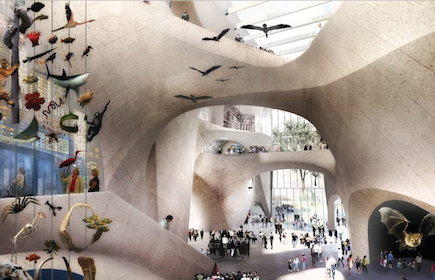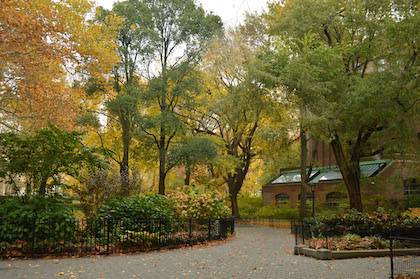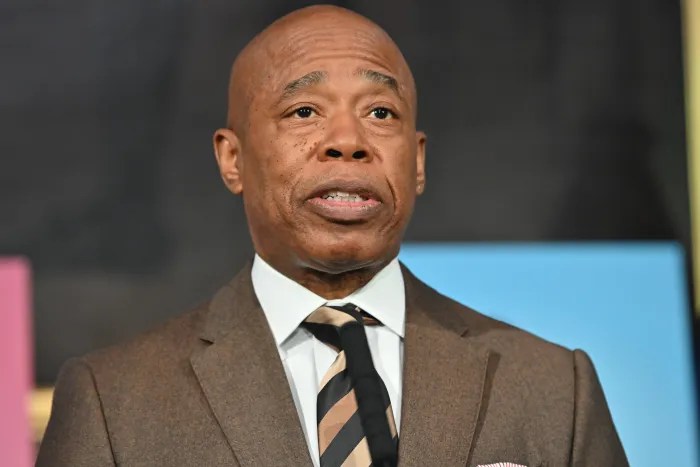
BY JACKSON CHEN | A November 12 informational session for the public hosted by the American Museum of Natural History, just over a week after it revealed its conceptual designs for a new science center to be constructed at its Columbus Avenue entrance, drew angry opposition to the plan’s encroachment onto the Theodore Roosevelt Park but also won praise from some neighborhood residents.
The conceptual plans, released on November 4, were the results of a year’s work from the lead architect Jeanne Gang of Studio Gang Architects, the landscape architect Joe James, and other members of the museum’s team.
The proposed design for the Gilder Center for Science, Education, and Innovation aims to address the museum’s growing need for an improved interior traffic flow allowing for less patron congestion. According to Ellen Futter, the museum’s president, the annual attendance figures have grown from three million to five million in the past several decades.
The new center would also allow the museum to provide more room for its vastly under-displayed collections — Futter said only two percent of the collection is available for viewing — and also make space for educationally-focused resources within the museum.
Given more than a week to review the initial designs, residents arrived fully prepared to voice their thoughts after the museum’s presentation.
Most of the residential opposition stemmed from concerns over the expansion gobbling up a portion of the Theodore Roosevelt Park. While the conceptual plan showed a drastically reduced footprint into the park compared to what had originally been discussed — 80 percent of the new Gilder Center would be built on the museum’s existing footprint — many critics felt any loss of parkland was devastating.

“The project would still consume a quarter-acre of parkland and remove nine majestic trees,” said Sig Gissler, president of the Defenders of Teddy Roosevelt Park. “In particular, we worry that the scope of the new entrance, with its attendant increase in foot traffic, would compromise the park’s role as a tranquil, intimate community gathering place.”
Gissler, who formed the park advocacy group in July, said the group has grown to about 3,000 supporters, who are “not anti-museum” but “pro-park.” While the group’s president thanked the museum for listening to their concerns, he’s still worried about the future of what he considers a “neighborhood sweet spot.”
Since the proposed conceptual design includes the removal of nine trees, James said that there are plans to transplant one of the trees and eventually replace the canopy by planting 17 new trees.
In comments to Manhattan Express prior to the public meeting, Gissler said that his group is always in favor of planting more trees, but that wouldn’t be a proper replacement for the mature trees that would be chopped down for the expansion. He said that they would continue to voice their concerns to the museum, since their action to date has yielded some improvement to design plans.
“We’re pleased we had some impact, but we’re still disappointed there’s still extensive loss of land and of trees,” he said.
Following Gissler’s comments, other members of the Defenders group suggested that 100 percent of the Gilder Center should be built within the museum footprint and that the museum had the alternative of constructing the new center on the museum’s parking structure located on its West 81th Street side.
However, Ann Siegel, the museum’s senior vice president for operations and capital programs, said that the Columbus Avenue location between 79th and 80th Streets was clearly the best location for solving the museum’s congestion problems and providing an open face for the center’s goal of science innovation.
When Gang pointed out that some in the community value the open space on top of the parking structure, members of the audience shouted out opposition to claims of it being an “important or beloved” public space. That in turn led other residents to shout their appreciation for the open space at the Arthur Ross Terrace above the museum’s parking lot.
At times, audience members hissed and laughed mockingly at comments from the museum, and Neil deGrasse Tyson, the director of the museum’s Hayden Planetarium, was interrupted in making remarks. He was able to voice his view that the concentration of activities and resources at the proposed Columbus Avenue expansion site would create a crosspollination of ideas for museum visitors that would inspire them and encourage innovation.
Some neighborhood residents spoke out in favor of the new Gilder Center. Longtime museum-goer and volunteer Jerry Halpern, a lifelong Upper West Sider, said the design was “enormously exciting.”
“It is an organic piece of architecture which makes vivid what I attempt to teach in the museum,” said Halpern, who volunteers as a museum tour guide. “Which is that our collections are a tool in the hands of not just the scientists, but the next generation that is coming up.”
Chris Hernandez, a city science teacher, said the museum and its proposed new science center would be a boon for his students and for education as a whole. The museum engages in educational collaborations with scores of schools across the city.
“Science education is going through a paradigm shift and an evolution of speed and scope that’s unprecedented,” Hernandez said. “Innovative, informal learning centers like this are needed more than ever to enrich what we do in the classroom.”

































